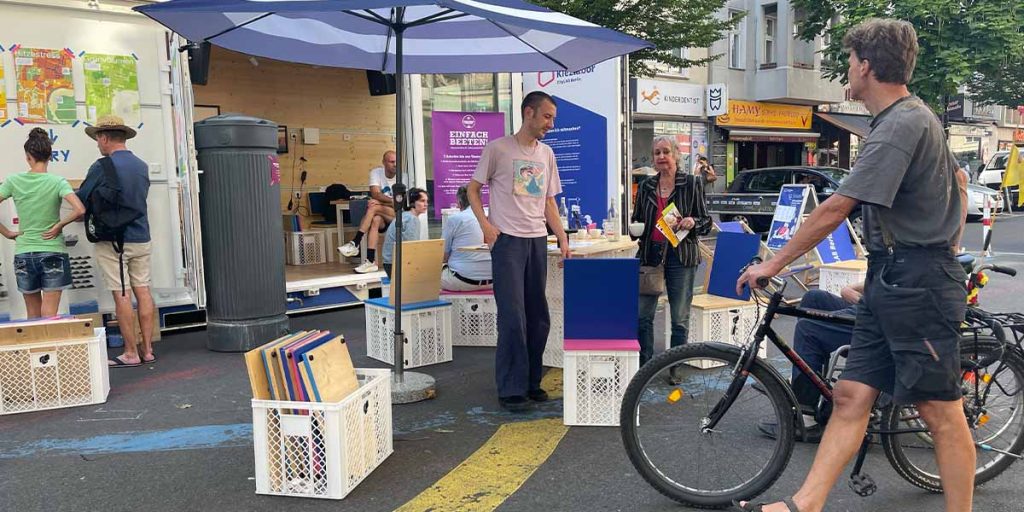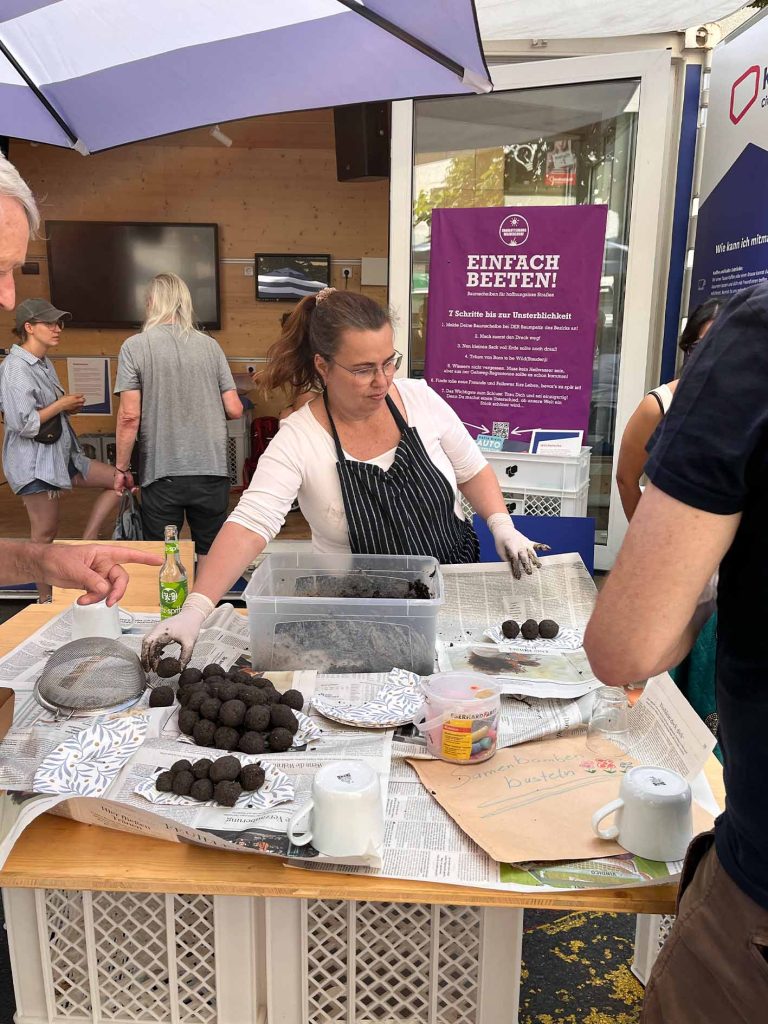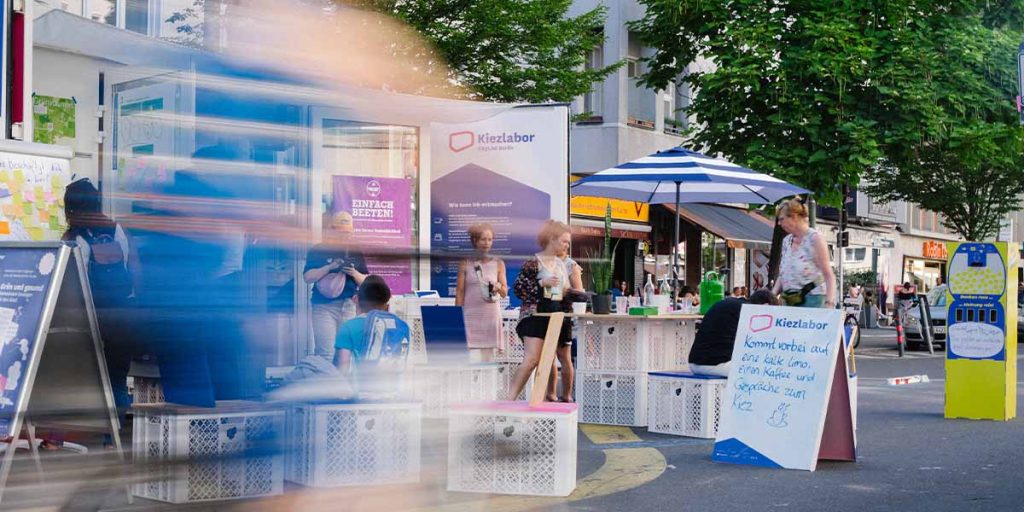Under the motto “Green and Healthy – Together, Let’s Bring Movement to the Neighborhood!” the Kiezlabor became a lively meeting point in the pedestrian zone of Wilmersdorfer Straße for eleven days in August. Movement was the central theme: Whether it was a herbal walk through the neighborhood or an audio walk that brought us closer to the world of Charlottenburg moths, we were actively engaged. The many conversations with passersby, who enriched the Kiezlabor with their ideas and opinions, were particularly inspiring.
What we experienced can be read in this blog post.

How do you envision the city of the future?
At previous locations, we used image-generative artificial intelligence (AI) to visualize ideas for streets, squares, and parks. This time, too, AI sparked a real flood of ideas in people. In different workshops, we wanted to find out with local residents: What makes the Karl-August-Kiez special in your eyes? Which structures promote neighborhood engagement, and where do you like to meet most? Your impressions were crucial, and we gathered many exciting opinions.
“At the AI workshop on citizen participation of the future, interesting discussions arose about AI in the social sector and in administration. It’s always nice to see different perspectives come together in the Kiezlabor and how various initiatives and actors get to know each other and network. Even children enjoy staying in the Kiezlabor, showing interest in AI applications and exhibits, and discovering the interconnected topics in a playful manner.”
Stefan from the Kiezlabor team
At the event “Mit KI zur Bürgerbeteiligung der Zukunft” (With AI Towards the Future of Citizen Participation), visitors, along with Interkulturanstalt Ulme35, explored the transformative potential of AI and discussed the possibilities it offers for democratic participation and strengthening citizen initiatives. Practical exercises were, of course, included!



Health, loneliness, and social connections in old age are also important aspects of a livable city. At the Get Togethers organized by the Network for Education and Social Affairs with Miriam Wuttke, many older people came together to discuss these topics. They learned about the Netzwerk Zukunftsmut 60+ project and the Zukunftsgarten, and many expressed a desire to volunteer and help implement small projects.

The Kiezlabor Satisfies Hunger and Thirst for Knowledge
Once again, visitors had the chance to join Simka von The Wild Path on a delicious walk through the neighborhood to search for seasonal wild and city plants. Found anything? Certainly! The harvest could then be prepared right at the Kiezlabor! Bon Appetit!
“A delicious pesto with Parmesan was made from local plants. Add to that some good bread and a side of cherries marinated in olive oil – mmmmm! This attracted even more interested visitors, who could trace the collection sites on a self-drawn map. Who would have thought there was so much edible stuff right around the corner!? The walk also helped to identify plants in the neighborhood. It has now achieved cult status – it was immediately requested for the next location.”
Caro from the Kiezlabor team


The Audiowalk “Open the Night” on the effects of light on insects with British artist Jeremy Knowles also took place for the second time at the Kiezlabor. With smartphones, participants embarked on an acoustic discovery journey. Our colleague Caro reports: “At several locations in the neighborhood, audio files were embedded in the app, transporting listeners acoustically into the moths’ world in the city. Very poetic, but also somewhat tragic. Moths perceive street lamps as the brightest light source, almost like the moon, and spiral around them until their last breath. About 200 moths die per street lamp each evening. The participants of the audio walk then considered how cities could be designed in harmony with other living beings in the future.”


From Seed to Plant – A Complete Lifecycle at the Kiezlabor
If you like plants, you definitely got your money’s worth at the Kiezlabor. Together with the neighborhood house at Lietzensee, seed balls were made. But also, sidewalk rain barrels to supply tree disks and raised beds with rainwater were showcased with the Fritschestraße initiative, hoping to find many imitators soon.
“Everyone listened very interested to Jörg from the Fritschestraße initiative. It was impressive: He knew all the people who passed by us or were sitting on one of the renovated historical benches. The microclimate created here is not only climatically excellent but also quite impressive is the new Initiative Einfach Beeten, which hopefully will help create many more such beautiful street spaces.”
Anne Kruse from the Kiezlabor team



We let trees and animals speak
What would the tree say? Things were particularly lively at the “Aktionstag Stadtbäume”. We tested our new exhibit “TreeBot” for the first time in public! With the prototype, it was possible to communicate with a tree using AI, and visitors got an insight into the role of AI in urban greenery. But not only the tree spoke; local initiatives such as Tiny Forest Berlin also presented themselves and shared a lot of knowledge about Berlin’s city trees to make Berlin a greener, more sustainable, and healthier place.
“It was wonderful to see how a diverse range of people visited throughout the day, sometimes intentionally and sometimes by chance, leading to natural exchanges and networking. From an interested lady to the political actors of “Tree Decision” to the initiative “Tiny Forests,” which is committed to greening tree disks – it was all there. And in the background, our new prototype ‘TreeBot’ chats with a child. For me, this is the essence of the Kiezlabor – exchange on an equal footing about urban topics.”
Henriette from the Kiezlabor team


Non-human voices are often excluded from decision-making in cities, and their experiences remain invisible in our city plans. What if we also brought non-human representatives “to the table”? Participants in the workshop “Council of Many Species” could take on different perspectives – for example, of squirrels, bats, or even nettles – and then explore the environment. Where would a bat like to eat, rest, or mate? “Through layering different experiences and subsequent idea generation, a neighborhood map was created that considers the well-being of all species,” reports Caro from the Kiezlabor team.
“How can holistic urban development be thought of? Holistically in the sense of including all life forms with which we share our urban space – animals, microorganisms, plants. We know from CityLAB and Kiezlabor how challenging it is to consider the different needs of residents. Nevertheless, we dare to explore the next level of difficulty and go with the workshop leader through the Kiez around Wilmersdorfer Straße to search for tracks and solutions.”
Markus from the Kiezlabor team



Art and Kiezlabor – an unbeatable duo
Many visitors were also drawn to the presentation of the artwork and participatory project “Pollinator Pathmaker” by artist Alexandra Daisy Ginsberg, presented by Sophie Korschildgen and Agnessa Schmudke from the LAS Art Foundation. Our colleague Caro was also present: “With the algorithm-based tool, the planting of small and large gardens (in urban space) can be planned to be pollinator-friendly, which could be tried out live at the Kiezlabor. What plants can not only please humans but also serve as food for pollinators? Even with a tree disk or a small bed, you can get started.”




What does the Kiezlabor bring us?
After ten days on Wilmersdorfer Straße with many offers, workshops, information, and discussions about the district and the lives of its residents, we reflected together with Bezirksstadtrat Oliver Schruoffeneger and the Raum für Beteiligung Charlottenburg-Wilmersdorf:
“At the celebratory closing event with Bezirksstadtrat Schruoffeneger, we were able to reflect on the time spent in Charlottenburg-Wilmersdorf with many very active partners and passing residents, and review the outcomes. According to the Bezirksstadtrat, the many contributions to the design of public spaces are very valuable. Not everything can be implemented, but many ideas can be incorporated into the future design manual for the Karl August Kiez. What stood out most was the mix of discussion, reflection, and friendly get-together to conclude the event.”
Anne from the Kiezlabor Team
“In my opinion, the pedestrian zone in Wilmersdorf was a great location for the Kiezlabor because there was constant activity – even during the summer holidays! Many people really took the time to explore the numerous exhibits in detail. I feel that we truly reached the people.”
Eva Schuh from Raum für Beteiligung / Bezirksamt Charlottenburg-Wilmersdorf
“My impression of the Kiezlabor? You can definitely connect with people quickly and really take the time for a conversation. Especially in longer discussions, ideas for the neighborhood were developed together with passersby.”
Frederike Büttner from Raum für Beteiligung / Bezirksamt Charlottenburg-Wilmersdorf
“I think the Kiezlabor is fantastic! Through the direct contact between the administration staff and passersby, we were able to make it transparent what issues we are currently working on and where residents can get directly involved.”
Dirk Jakubczick, Sachbearbeiter Klimaanpassung / Bezirksamt Charlottenburg-Wilmersdorf



So, what does the Kiezlabor bring us? A whole lot! The Kiezlabor brings neighborhoods together, fosters exchange, inspires creative ideas for urban design, and enables future-oriented civic participation. We want to create a space with the Kiezlabor where health, sustainability, and community engagement are at the center – coming soon to Kreuzberg and Pankow!
